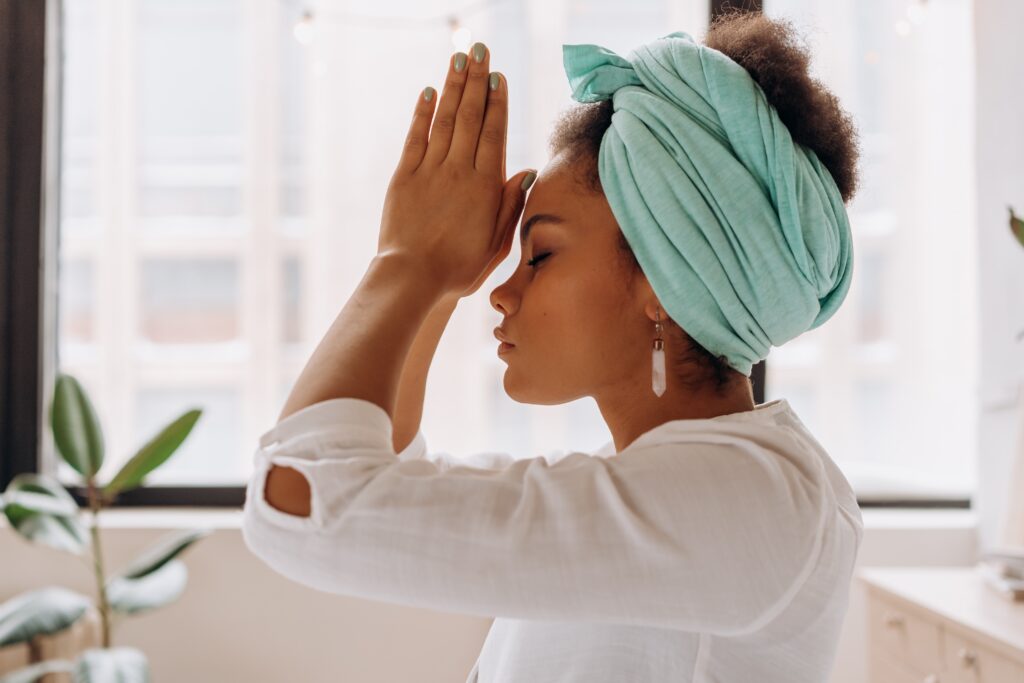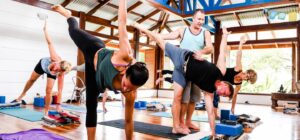If you’ve ever gone to a yoga class, you’re probably familiar with the word Namaste. Yoga teachers often conclude classes by saying this Sanskrit word as an expression of oneness.
Namaste, a traditional Indian blessing, is typically said when meeting or leaving someone. When speaking, the person typically brings their hands together in a prayer position to their heart center. One interpretation of Namaste is, “The Divine in me honors the Divine in you”. This essentially means, “We are one and the same”. The blessing is about honoring oneness and equality, recognizing that all are created from the same essence.
The gesture Namaste represents the belief that there is a Divine spark within each of us that is located in the heart chakra. The gesture is an acknowledgment of the soul in one by the soul in another. Here’s a breakdown of the word:
“Nama” (bow)
“as” (I),
“te” (you)
Therefore, Namaste literally means “bow me you” or “I bow to you.”
How To Practice Namaste
To practice Namaste, place your hands together at the heart charka, close your eyes, and bow your head. It can also be done by placing your hands together in front of your third eye, bowing your head, and then bringing your hands down to your heart.
Namaste is a deep form of respect. Although in the West the word Namaste is usually spoken in conjunction with the gesture, in India, it is understood that the gesture itself signifies Namaste, and therefore, it is unnecessary to say the word while bowing.
We bring the hands together at the heart chakra to increase the flow of Divine love. Bowing the head and closing the eyes helps the mind surrender to the Divine in the heart. One can do Namaste to oneself as a meditation technique to go deeper inside the heart chakra; when done with someone else, it is also a beautiful, albeit quick, meditation.

For a teacher and student, Namaste allows two individuals to come together energetically to a place of connection and timelessness, free from the bonds of ego-connection. If it is done with deep feeling in the heart and with the mind surrendered, a deep union of spirits can blossom.
Ideally, Namaste should be done both at the beginning and at the end of class. Usually, it is done at the end of class because the mind is less active and the energy in the room is more peaceful. The teacher initiates Namaste as a symbol of gratitude and respect toward their students and their own teachers and in return invites the students to connect with their lineage, thereby allowing the truth to flow—the truth that we are all one when we live from the heart.
Prayer Hands
The drawing together of one’s palms at the heart always accompanies the speaking of the word Namaste. You may find this hand gesture within certain asanas—in Tadasana (Mountain Pose), before you begin Sun Salutations, or in balance poses such as Vrksasana (Tree Pose). This sacred hand position called anjali mudra (AHN-jah-lee MOO-dra), is found throughout Asia and has become synonymous with our images of the East, from the smiling face of the Dalai Lama peering over his fingertips to images of devotees before a Hindu or Buddhist altar.

In the West, we translate this gesture as a posture of prayer. Because we have grown up with this gesture as part of our culture, each of us probably has our own personal connection to this mudra—positive or negative.
The beauty of this gesture is that it positions us right at the core of our being, signifying our timeless and universal nature. As we explore the significance and potential of this mudra, be open to your own experience and ways that this simple yet powerful hand position can be a practical tool in your practice and daily life.
What is a Mudra?
In Sanskrit, mudra means “seal” or “sign” and refers not only to sacred hand gestures but also whole body positions that elicit a certain inner state or symbolize a particular meaning. Anjali mudra is but one of thousands of types of mudras that are used in Hindu rituals, classical dance, and yoga.
Anjali itself means “offering,” and in India this mudra is often accompanied by the word Namaste (or “namaskar,” depending on one’s dialect). As the consummate Indian greeting, like a sacred hello, Namaste is often translated as “I bow to the divinity within you from the divinity within me.” This salutation is at the essence of the yogic practice of seeing the Divine within all of creation. Hence, this gesture is offered equally to temple deities, teachers, family, friends, strangers, and before sacred rivers and trees.

Anjali mudra is used as a posture of composure, of returning to one’s heart, whether you are greeting someone or saying goodbye, initiating or completing an action. As you bring your hands together at your center, you are literally connecting the right and left hemispheres of your brain. This is the yogic process of unification, the yoking of our active and receptive natures. In the yogic view of the body, the energetic or spiritual heart is visualized as a lotus at the center of the chest. Anjali mudra nourishes this lotus heart with awareness, gently encouraging it to open as water and light do to a flower.
How to Practice Anjali Mudra
- Begin by coming into a comfortable sitting position like Sukhasana (Easy Pose).
- Lengthen your spine out of your pelvis and extend the back of your neck by dropping your chin slightly in.
- Now, with open palms, slowly draw your hands together at the center of your chest as if to gather all of your resources into your heart.
- Repeat that movement several times, contemplating your own metaphors for bringing the right and left side of yourself—masculine and feminine, logic and intuition, strength and tenderness—into wholeness.
- Now, to reveal how potent the placement of your hands at your heart can be, try shifting your hands to one side or the other of your midline and pause there for a moment.
- Notice if you feel slightly off-kilter.
- Now shift back to center and notice how satisfying the center line is, like a magnet pulling you into your core.
- Gently touch your thumbs into your sternum (the bony plate at the center of the rib cage) as if you were ringing the bell to open the door to your heart.
- Broaden your shoulder blades to spread your chest open from the inside.
- Feel space under your armpits as you bring your elbows into alignment with your wrists. Stay here for some time and take in your experience. What initial shifts of consciousness do you experience? Is there a change in your mood?
Other Uses For Anjali Mudra
Now imagine that you are beginning your yoga practice—or any activity in which you want to be centered and conscious of how your inner state will affect the outcome of your experience. Take anjali mudra again, but this time slightly part your palms as if to make a cup, so that your hands resemble the bud of a lotus flower. Depending on your spiritual orientation, you can metaphorically plant a seed prayer, affirmation, or quality such as “peace,” “clarity,” or “vitality” within your anjali mudra.

Drop your chin towards your chest and awaken a sense of humility and awe with which to begin your practice, as if waiting to receive a blessing of good things to come. It is important that this anjali or offering be true to your Self as that will be the most effective and uplifting for you.
Traditionally, yogis might visualize their ishta devata (or personal connection) to God within the shrine of their hands. For some people this may be a sacred mountain, for others, Jesus, Krishna, or the Mother Goddess. Align your mind (awareness), feeling (heart), and actions (body) within this gesture. When you feel your invocation is complete, draw your fingertips to the center of your forehead, ajna chakra, and pause there feeling the calming effect of your touch. Bring your hands back to your center to ground your intention within your heart.
From here you can begin your yoga asanas, meditation, or any activity from a place of connectedness. Notice how much easier it is to be present and joyous with whatever you are doing. Look for other times to integrate anjali mudra into your practice and life. Besides the beginning and end of your yoga sessions, anjali mudra can be used within the Sun Salutations and many other asanas as a way to come back to and maintain your center.

When your hands come together overhead in Virabhadrasana I (Warrior I) or in Tree Pose, this is still anjali mudra. Consciously connecting this upward movement of your hands through an invisible line of energy to your heart will help your posture and your inner attitude.
In daily life, this prayerful gesture can be used as a way of bridging your inner and outer experience, when saying grace before meals, communicating your truth within a relationship, or as a means of cooling the fires of stress when feeling rushed or reactionary. Anjali mudra is an age-old means of helping human beings to remember the gift of life and to use it wisely.
If you are drawn to learn more about yoga philosophy, perhaps it is time to look into whether a yoga teacher training is right for you. At Blue Osa, we offer immersive options allowing our students the time and space in the sacred and magical container of the Osa Peninsula to dedicate themselves fully to a guaranteed life-transformational experience.
We are here to support you in any questions you may have.
Namaste.









